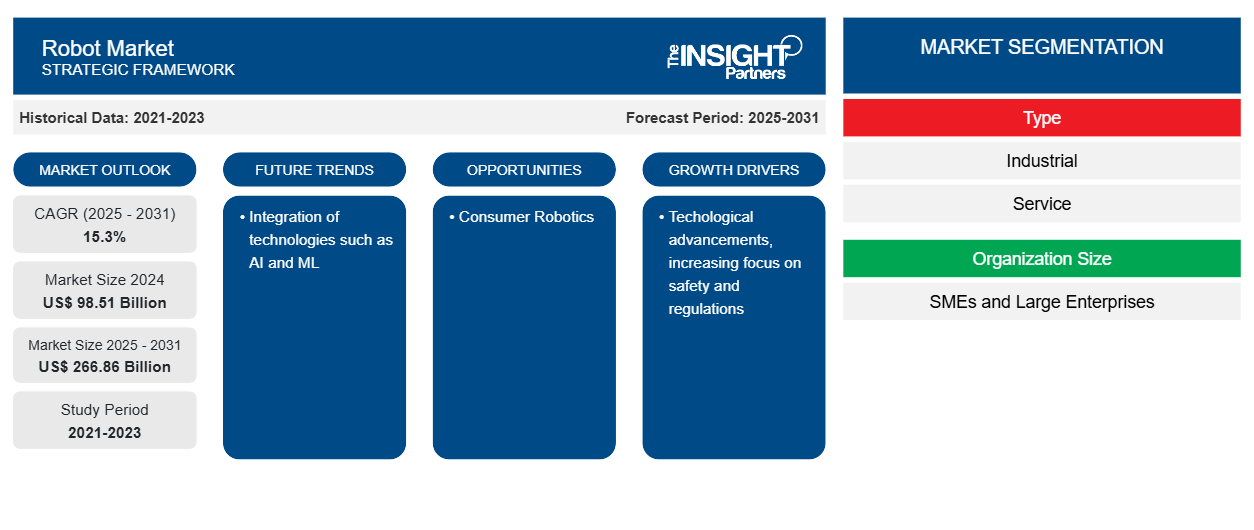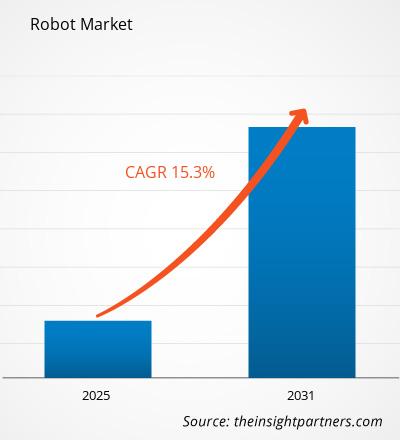The robot market size is projected to reach US$ 266.86 billion by 2031 from US$ 85.44 billion in 2023. The market is expected to register a CAGR of 15.3% during 2023–2031. Integration of technologies such as AI and ML are likely to remain key trends in the market.
Robot Market Analysis
The market has witnessed a steady rise over the past few years, primarily fueled by the rising adoption of Industry 4.0 and digital transformation across verticals. Extrinsic factors, such as the COVID-19 pandemic, geopolitical turmoil, and supply chain disruptions, have positively impacted the adoption of service and industrial robots in recent years. Similarly, intrinsic factors, such as usability and technological advancements, have positively impacted robot development and adoption. The pandemic augmented both automation acceptance and digital transformation across the various sectors. It also includes software for remote monitoring and those that enable the adoption of industrial automation.
Robot Market Overview
A robot can be termed an autonomous or semi-autonomous mechanical device programmed to perform tasks. It often can interact with its surroundings and accurately follow the programmed instructions. Robots' design, construction, application, and operation fall under robotics, a branch of technology. Robots can range from simple single-purpose devices to articulate machines programmed to perform several complex tasks simultaneously. Presently, different types and forms are available in the market and are often customized by the manufacturer based on their intended application. For several applications, which are repetitive, limit the application of humans, and can be dangerous, humans have been replaced with humanoid robots.
Customize This Report To Suit Your Requirement
You will get customization on any report - free of charge - including parts of this report, or country-level analysis, Excel Data pack, as well as avail great offers and discounts for start-ups & universities
Robot Market: Strategic Insights

-
Get Top Key Market Trends of this report.This FREE sample will include data analysis, ranging from market trends to estimates and forecasts.
Robot Market Drivers and Opportunities
Strong Adoption of Industry 4.0 to Favor Market
Industry 4.0 refers to the growth in automation of traditional industries through technical breakthroughs such as the Internet of Things (IoT) and cyber-physical technologies to make factories smarter. Robotics has been fundamental in advancing Industry 4.0, resulting in heightened productivity and proficiency in manufacturing operations. Productivity has risen significantly due to robot's usage for various manufacturing processes. Robots can perform repetitive jobs faster and more precisely, resulting in faster manufacturing. The robots have eliminated the requirement for human workers to perform hazardous activities through the automation of manufacturing processes, resulting in a reduction in workplace accidents.
Consumer Robotics
The consumer robotics market has a bright future, however, it also confronts substantial difficulties that will necessitate new solutions and strong tactics to ensure its continued growth and general acceptance in society. The growing need for convenience, as well as greater purchasing power among customers in industrialized countries, drives demand for robotic devices for home and entertainment.
Robot Market Report Segmentation Analysis
Key segments that contributed to the derivation of the robot market analysis are type, organization size, and vertical.
- Based on type, the robot market is divided into industrial and services. Articulated, cartesian and others are two prominent subsegments under the industrial segment. The industrial segment held a larger market share in 2023.
- By organization size, the market is segmented into SMEs and large enterprises.
- By vertical, the market is segmented into aerospace and defense, automotive, electronics and semiconductor, healthcare, IT and telecom, manufacturing, retail and e-commerce, transportation and logistics, and others.
Robot Market Share Analysis by Geography
The geographic scope of the Robot market report is mainly divided into five regions: North America, Asia Pacific, Europe, Middle East & Africa, and South & Central America.
North America holds a prominent share in the market. Industry 4.0 is widely adopted in the region and has a higher acceptance of advanced technology. Additionally, the region is a pioneer in developing and deploying robotic technologies. Furthermore, the US and Canada have witnessed a significant rise in digital transformation amongst enterprises and industries across various sectors. E-commerce is one such vertical that has significantly surged in the past few years. The usage in warehouses of e-commerce players has spiked during the pandemic and continues to grow to date.
Robot Market Regional Insights
The regional trends and factors influencing the Robot Market throughout the forecast period have been thoroughly explained by the analysts at The Insight Partners. This section also discusses Robot Market segments and geography across North America, Europe, Asia Pacific, Middle East and Africa, and South and Central America.
Robot Market Report Scope
| Report Attribute | Details |
|---|---|
| Market size in 2024 | US$ 98.51 Billion |
| Market Size by 2031 | US$ 266.86 Billion |
| Global CAGR (2025 - 2031) | 15.3% |
| Historical Data | 2021-2023 |
| Forecast period | 2025-2031 |
| Segments Covered |
By Type
|
| Regions and Countries Covered |
North America
|
| Market leaders and key company profiles |
|
Robot Market Players Density: Understanding Its Impact on Business Dynamics
The Robot Market is growing rapidly, driven by increasing end-user demand due to factors such as evolving consumer preferences, technological advancements, and greater awareness of the product's benefits. As demand rises, businesses are expanding their offerings, innovating to meet consumer needs, and capitalizing on emerging trends, which further fuels market growth.

- Get the Robot Market top key players overview
Robot Market News and Recent Developments
The robot market is evaluated by gathering qualitative and quantitative data post primary and secondary research, which includes important corporate publications, association data, and databases. A few of the developments in the robot market are listed below:
- OSARO, a global leader in machine-learning-enabled robotics for e-commerce, is partnering with FANUC America, the leading supplier of CNCs, robotics, and ROBOMACHINEs, to expand the capabilities of FANUC’s robotic automation solutions optimized for warehousing and e-commerce fulfillment. The two companies will collaborate on go-to-market strategies, commencing with the installation of an advanced piece-picking demonstration robot at FANUC’s Innovation Center in Rochester Hills, Michigan. (Source: OSARO, Newsletter, 2023)
- ABB Robotics is expanding its large robot range with four new models and 22 variants, offering more choice, increased coverage, and greater performance. The next generation models include the IRB 6710, IRB 6720, IRB 6730, and IRB 6740, suitable for payloads ranging from 150kg to 310kg, with a reach from 2.5m to 3.2m, offering customers greater choice and significant performance and energy efficiency improvements. (Source: ABB, Newsletter, 2023)
Robot Market Report Coverage and Deliverables
The “Robot Market Size and Forecast (2021–2031)” report provides a detailed analysis of the market covering below areas:
- Robot market size and forecast at global, regional, and country levels for all the key market segments covered under the scope
- Robot market trends as well as market dynamics such as drivers, restraints, and key opportunities
- Detailed PEST/Porter’s Five Forces and SWOT analysis
- Robot market analysis covering key market trends, global and regional framework, major players, regulations, and recent market developments
- Industry landscape and competition analysis covering market concentration, heat map analysis, prominent players, and recent developments for the Robot market
- Detailed company profiles
Frequently Asked Questions
Which region dominated the robot market in 2023?
What are the driving factors impacting the robot market?
What would be the estimated value of the robot market by 2031?
What are the future trends of the robot market?
Which are the leading players operating in the robot market?
What is the expected CAGR of the robot market?
- Historical Analysis (2 Years), Base Year, Forecast (7 Years) with CAGR
- PEST and SWOT Analysis
- Market Size Value / Volume - Global, Regional, Country
- Industry and Competitive Landscape
- Excel Dataset
Recent Reports
Related Reports
Testimonials
Reason to Buy
- Informed Decision-Making
- Understanding Market Dynamics
- Competitive Analysis
- Identifying Emerging Markets
- Customer Insights
- Market Forecasts
- Risk Mitigation
- Boosting Operational Efficiency
- Strategic Planning
- Investment Justification
- Tracking Industry Innovations
- Aligning with Regulatory Trends





















 Get Free Sample For
Get Free Sample For